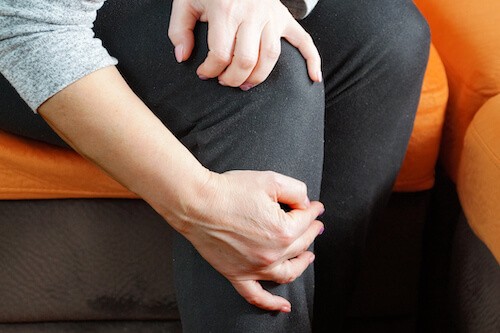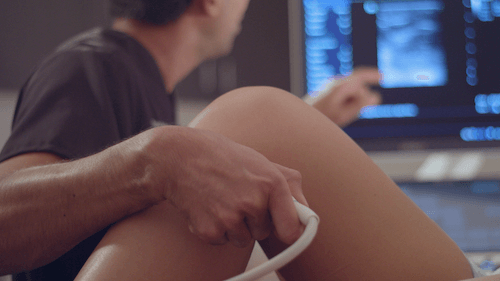Leg Swelling Related to Inflammation
Swelling in the legs due to inflammation can be caused by a number of underlying health conditions.
Normally the endothelial surface is smooth and allows the blood to flow freely. However, when there is increased pressure in the veins, such as from faulty valves or activities that involve prolonged standing or sitting, the endothelium is harmed. This triggers the inflammatory process which brings white blood cells and other components of the healing process to repair the damage[1].
When inflammation in the veins becomes chronic, it results in turbulent blood flow, increased blood pressure in the veins, and leakage of the fluid portion of the blood into surrounding tissues, resulting in swelling.
Additionally, kidney, heart, or liver disease, or certain medications can cause leg swelling[2].
How to Treat: Leg swelling should always be checked by a doctor who can provide a thorough examination and accurate diagnosis. Swelling in the legs that is caused by inflammation from faulty vein valves or chronic venous insufficiency can be treated with VenaSeal™. VenaSeal™ is a minimally invasive procedure that is virtually pain-free, takes only 20 minutes in our clinic, and allows patients to resume their normal activities the same day.

Leg Swelling Related to Fluid Buildup
A number of factors other than inflammation can cause leg swelling due to fluid buildup in the legs.
These include:
Obesity
Excess abdominal fat in obese individuals puts pressure on the lower abdomen that obstructs venous blood flow from the legs. A study was conducted to simulate this effect in which researchers placed a compression cuff around the abdomen of non-obese volunteers. Results showed increased pressure in the leg veins and venous stasis, a slowing of the blood flow in the legs[3].
Additionally, adipose tissue secretes hormones and other signaling molecules that are known to disrupt endothelial function, which can cause turbulent and sluggish blood flow in the veins, increased venous blood pressure, and ultimately lead to swelling of the legs[4].
How to Treat: Losing weight is the best and only permanent remedy. Weight loss also makes it easier to get the exercise you need for healthy circulation. And it reduces or eliminates other risk factors for leg swelling, such as heart disease and diabetes.

Sitting for Long Periods of Time
Prolonged sitting, whether at a desk, on long drives, or long airline flights, slows circulation and can impair venous circulation from the legs. This happens because in the seated position, your legs are lower than your heart and venous blood has to travel against gravity to get back to your heart and lungs. Also, in the seated position your hips are flexed, which can place additional pressure on blood vessels in that area. Not to mention that sitting is a sedentary activity. While you’re sitting your circulation is naturally slower plus it’s not getting assistance from the muscular pump mechanism that helps return blood flow when you are walking.
All of these factors together make prolonged sitting a hazardous activity for the circulation in your legs. The effects of sitting are such that even healthy young adults experience swelling in the legs[5].
How to Treat: Disrupting a long period of sitting with intermittent bursts of activity can help reduce the accumulated swelling and get your blood moving. In one study, 3 minutes of physical activity performed each hour during a 4-hour sitting session significantly reduced lower leg swelling and also reduced levels of pro-inflammatory markers[5]. The bursts of activity included gentle cycling and 20-second sprints followed by 95-second cool down exercises.
If your seated activity doesn’t allow for short bursts of exercise, such as on a long airplane flight, you can prevent or reduce leg swelling by doing ankle exercises. Ankle circles, tracing the alphabet with your toe and paddling your feet (i.e. alternating pointing and flexing the ankles), activate the calf muscle pump that pushes venous blood away from the legs toward the heart. For these occasions, compression stockings are also helpful.
Standing for Long Periods of Time
Prolonged standing, like sitting, requires blood to be moved from the feet and legs against gravity without the assistance of the calf muscles providing pressure against the veins. Occupations that involve long periods of standing are associated with higher risk for leg swelling that can lead to varicose veins. And, as for sitting, this tendency doesn’t discriminate by age. Research shows that even healthy young adults experience measurable leg swelling and muscle fatigue after long bouts of standing[7].
How to Treat: Ankle and hip range of motion exercises can help counteract the effects of prolonged standing. In one study, participants stood for 4 hours, during which they practiced either ankle exercises (wiggling the toes) or hip exercises (knee raises) every thirty minutes. Ankle exercises resulted in 40% less leg swelling and hip exercises resulted in 20% less swelling compared to standing for the same amount of time without performing these exercises[8].
Additionally, the type of shoes you wear and the type of floor you stand on can help or hurt your legs. If possible, wear athletic shoes and stand on shock absorbing mats. These reduce impact on your muscles and joints resulting in less swelling, less fatigue, and greater comfort[9].

Deep Vein Thrombosis (DVT) or Thrombophlebitis
Deep vein thrombosis (DVT) is a blood clot in a vein near the center of the leg. These can remain asymptomatic until they grow large enough to attach to the wall of the vein. When this happens, they cause an inflammatory reaction, and the affected leg quickly becomes swollen and painful[10].
DVT can become a medical emergency if a small piece of the clot breaks off and is carried in the venous circulation to the lungs, where it can cause a life-threatening occlusion or pulmonary embolism. For this reason, swelling in the legs should always be diagnosed and treated by a qualified medical doctor.
Thrombophlebitis is an underlying inflammatory condition that causes blood clots to form. Blood clots resulting from thrombophlebitis can develop in superficial veins – those near the surface, or in deep veins. Superficial thrombophlebitis does not have a risk of pulmonary embolism and can be managed at home.
How to Treat:
- Elevating the legs - uses gravity to assist blood flow and reduce swelling. It’s best to have your lower legs higher than the level of your heart.
- Compression stockings - promotes return blood flow and helps to prevent swelling in the legs. Compression stockings can be used when elevation is not an option.
- Warm water or saltwater compress - stimulates blood flow and soothes the legs. Both have been found to be equally effective[11]. This should ideally be done for 30 minutes 3-4 times per day[12].
Chronic Venous Insufficiency
Chronic venous insufficiency is a condition in which the valves in the leg veins don’t function adequately and/or there is damage to the inner lining of the veins resulting in poor blood flow, increased blood pressure in the veins, fluid leakage, and swelling.
How to Treat:
- Elevating the legs – This can bring immediate relief of discomfort and reduce swelling. Aim for 15 minutes per session, 2-4 times per day[13].
- Compression stockings – Prevent swelling and may also reduce the risk of ulcer formation, according to a 2019 review of studies on chronic venous insufficiency in elderly patients[14].
- Exercise – Walking strengthens the calf muscles and activates the calf muscle pump. Start slow and with your doctor’s supervision gradually build up your distance and speed. Calf range of motion and strengthening exercises with resistance bands are also effective and can help speed the progress of your walking routine.
- Herbal Supplements – Medicinal herbs and plant extracts such as quercetin, pine bark extract, ginkgo biloba, and butcher’s broom, contain high levels of flavonoid compounds with antioxidant and anti-inflammatory effects that have been found to benefit circulation in the legs and reduce swelling[15].

VenaSeal™ Closure System
If your leg swelling is caused by varicose veins or chronic venous insufficiency and your symptoms are worsening or self-management is not producing adequate symptom relief, the VenaSeal™ Closure System may be an excellent option for you. VenaSeal™ is a minimally invasive procedure that is virtually pain-free, takes only 20 minutes in our clinic, and allows patients to resume their normal activities the same day.
Desert Vein and Vascular Institute is the top provider of VenaSeal™, the leading outpatient varicose vein treatment, in the USA.
To schedule a free consultation to find out if VenaSeal™ is right for your varicose veins or chronic venous insufficiency, please call 1-800-827-4267 today.
References
- Inflammation in chronic venous insufficiency. Is the problem insurmountable? J Vasc Res, 1999. 36 Suppl 1: p. 3-10
https://www.ncbi.nlm.nih.gov/pubmed/10474045 - Gross-dependent lower limb lymphoedema. Clin Case Rep, 2017. 5(2): p. 150-153
https://www.ncbi.nlm.nih.gov/pubmed/28174641 - The influence of abdominal pressure on lower extremity venous pressure and hemodynamics: a human in-vivo model simulating the effect of abdominal obesity. Eur J Vasc Endovasc Surg, 2011. 41(6): p. 849-55
https://www.ncbi.nlm.nih.gov/pubmed/21414818 - Mechanisms of endothelial dysfunction in obesity. Clin Chim Acta, 2005. 360(1-2): p. 9-26
https://www.ncbi.nlm.nih.gov/pubmed/15982646 - Disrupting prolonged sitting reduces IL-8 and lower leg swell in active young adults. BMC Sports Sci Med Rehabil, 2019. 11: p. 23
https://www.ncbi.nlm.nih.gov/pubmed/31636910 - Leg fluid accumulation during prolonged sitting. Annu Int Conf IEEE Eng Med Biol Soc, 2016. 2016: p. 4284-4287
https://www.ncbi.nlm.nih.gov/pubmed/28269228 - Physiological changes during prolonged standing and walking considering age, gender and standing work experience. Ergonomics, 2020. 63(5): p. 579-592
https://www.ncbi.nlm.nih.gov/pubmed/32009579 - Effectiveness of leg movement in reducing leg swelling and discomfort in lower extremities. Appl Ergon, 2012. 43(6): p. 1033-7
https://www.ncbi.nlm.nih.gov/pubmed/22472344 - Influence of shoe/floor conditions on lower leg circumference and subjective discomfort during prolonged standing. Appl Ergon, 2012. 43(5): p. 965-70
https://www.ncbi.nlm.nih.gov/pubmed/22342130 - The Diagnosis and Management of Early Deep Vein Thrombosis. Adv Exp Med Biol, 2017. 906: p. 23-31
https://www.ncbi.nlm.nih.gov/pubmed/27638622 - Warm Water Compress as an Alternative for Decreasing the Degree of Phlebitis. Compr Child Adolesc Nurs, 2017. 40(sup1): p. 107-113
https://www.ncbi.nlm.nih.gov/pubmed/29166201 - Instruction Sheet: Superficial Thrombophlebitis. University of North Carolina Wilmington
https://uncw.edu/healthservices/documents/instructionsheet-superficialthrombophlebitis512.pdf - Chronic venous insufficiency.
https://health.ucdavis.edu/vascular/diseases/cvi.html - Effects of preventive use of compression stockings for elderly with chronic venous insufficiency and swollen legs: a systematic review and meta-analysis. BMC Geriatr, 2019. 19(1): p. 76
https://www.ncbi.nlm.nih.gov/pubmed/30845919 - Therapeutic potential of natural compounds in inflammation and chronic venous insufficiency. Eur J Med Chem, 2019. 176: p. 68-91
https://www.ncbi.nlm.nih.gov/pubmed/31096120
